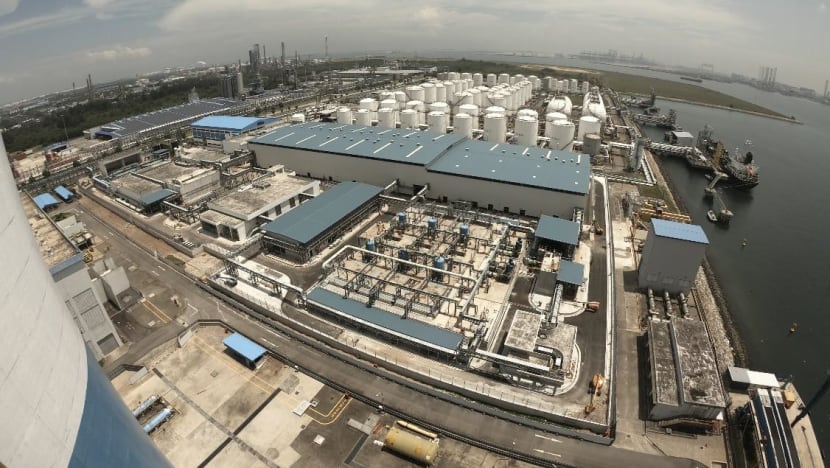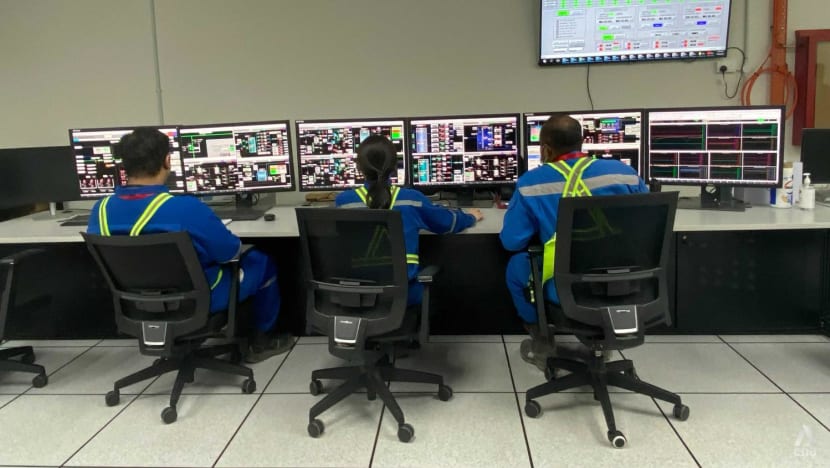Singapore officially opens fifth desalination plant which is 5% more energy efficient

An aerial view of the Jurong Island Desalination Plant. (Photo: PUB)
SINGAPORE: Singapore on Sunday (Apr 17) officially opened the country’s fifth desalination plant, which is about 5 per cent more energy efficient than conventional desalination plants.
Due to its co-location with an existing power plant, the Jurong Island Desalination Plant can save about 5,000 megawatt hours per year, equivalent to the annual power needs of nearly 1,000 Housing and Development Board households.
The new facility, which has been operational since earlier this month, was officially opened by Deputy Prime Minister Heng Swee Keat and Minister for Sustainability and the Environment Grace Fu on Sunday.
The 3.7-hectare plant can produce up to 30 million gallons of fresh drinking water per day, equivalent to 55 Olympic-sized swimming pools of water or up to 7 per cent of Singapore’s daily water demand.
Constructed under the Design, Build, Own and Operate model, the Jurong Island Desalination Plant will be operated by a consortium formed by Tuas Power and ST Engineering for a 25-year period. The consortium was picked as preferred bidder for the project in 2017.
The new desalination plant is co-located with Tuas Power’s Tembusu Multi- Utilities Complex (TMUC), which has been up and running since 2013 and houses a power plant.
Being located in close proximity and integrated with TMUC’s power plant allows the new desalination plant to “derive synergies in resources”, such as sharing of sea water intake and outfall structures, as well as energy from in-plant generational facilities, said PUB and the consortium.
For example, the feedwater for the Jurong Island Desalination Plant comes from the sea water that the power plant uses for cooling purposes. The warm sea water is then channeled to the desalination plant where the process of water treatment begins.
This helps to provide “slightly cleaner feedwater” as there is a basic level of filtration at the point the sea water enters TMUC. The Jurong Island Desalination Plant also enjoys reduced pumping cost for sea water as a result, said Tuas Power president and chief executive Jiang Hanbin in a speech delivered at the opening ceremony.
Another energy-saving aspect comes from how the power required for the new desalination plant is drawn from the embedded generator in the power plant, explained Tuas Power’s Mr Tan Chek Jiang, who is the plant manager for the Jurong Island Desalination Plant. This helps to save on network charges, thereby reducing the plant’s operating costs.
INNOVATING SOLUTIONS
But building a full-fledged desalination plant on existing infrastructure required “innovative” engineering solutions, its builders said.
This included creating modular systems in different areas of the desalination process and the pre-fabrication of equipment, such as the reverse osmosis units to simplify and speed up the assembly process.
"The design and construction of the Jurong Island Desalination Plant has provided ST Engineering the opportunity to leverage our expertise in large-scale engineering projects in the marine sector to deliver complex environmental engineering solutions,” said ST Engineering’s president for marine Ng Sing Chan.
Apart from being one of the more energy efficient plants in Singapore, the Jurong Island Desalination Plant is also equipped with the latest proven water-treatment equipment and membrane technologies, such as dissolved air flotation, ultra-filtration and reverse osmosis.Given how it is highly automated, it needs just a three-man team to run the entire plant’s operations from a control room.

MAKING DESALINATION MORE ENERGY-EFFICIENT
Construction for the Jurong Island Desalination Plant began in 2018. The plant was initially slated to open in 2020 but faced delays due to the COVID-19 pandemic which brought about global shortages of materials and resources. Border restrictions and safe management measures also threw up difficulties for the plant’s completion.
The country’s four other desalination plants are the SingSpring Desalination Plant, Tuas South Desalination Plant, Tuas Desalination Plant and the Keppel Marina East Desalination Plant, which began operations in 2005, 2013, 2018 and 2020 respectively.
Desalination, which involves converting sea water to drinking water, is one of Singapore’s “four national taps”. The other three sources are water from local catchments, imported water from Johor and NEWater, which is treated used water.
“Although seawater desalination is the most expensive way to produce water, due to the energy required, it is nevertheless an essential source of drinking water for Singapore,” said PUB’s chef executive Ng Joo Hee in the press release.
This as desalination is immune to the vagaries of weather, he added, noting that that the efficiencies of the Jurong Island Desalination Plant “make the energy-take for desalination that much more palatable”.
Desalination is an energy-intensive process. At the moment, desalinated water in Singapore is produced via reverse osmosis, which involves pushing sea water through membranes to remove dissolved salts and minerals.
The technology uses about 3.5 kilowatt hour per cubic meter (kWh/m3) of energy to make seawater drinkable, according to PUB, which has been exploring ways to reduce the energy required.
Speaking at the opening ceremony, Mr Heng noted that PUB will be building a desalination Integrated Validation Plant in Pasir Ris to trial promising technologies for implementation in full-scale desalination plants.
Through the scale-up and validation of these technologies, the energy to produce one cubic meter of desalinated water could potentially be reduced from 3.5 kilowatt hours to less than 2 kilowatt hours by 2025, he said.
Singapore will also continue to devote resources to other areas of water research under the national Research, Innovation and Enterprise 2025 plan. This includes enhancing the efficiency of used water treatment, as well as developing innovative solutions to reduce industrial water consumption, said the Deputy Prime Minister.
While the completion of the Jurong Island Desalination Plant marks another key milestone in the country’s water journey, Mr Heng stressed that the country must not lose sight of the fact that water security in Singapore does not come easily.
“We may not feel it in our everyday lives, because we no longer have water rationing like in the 1960s, and clean water flows readily from our taps. But this did not happen by chance – it required sustained commitment of resources, and a strong focus on research and development,” he said, adding that each of the four national taps has its own limitations such as weather-dependency and costs.
“But I am confident that we will continue to find new ways to increase the efficiency of our water supply, even as we enhance our water resilience,” said Mr Heng. “But to ensure that we have true water security, we also cannot just focus on the supply side of the equation.”
Singapore currently consumes about 430 million gallons of water a day – enough to fill 782 Olympic-sized swimming pools – with the industrial sector accounting for more than half of this demand.
Authorities have said that water demand is set to nearly double by 2060.
With that, Mr Heng urged all to play their part to conserve water. For example, businesses can do more to conserve water given how that would also help to reduce their operating costs.
“I encourage more businesses to work with PUB in pushing the boundaries of water conservation,” he said.
















